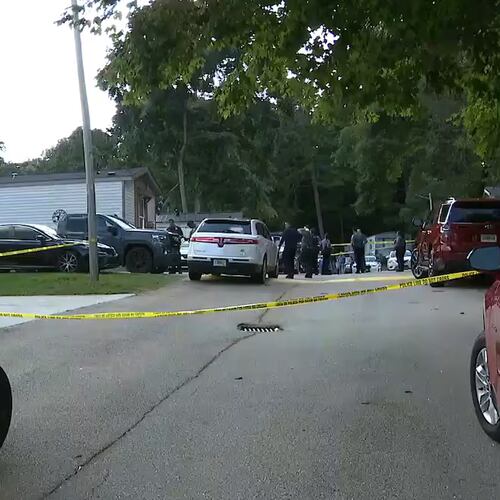You may not know the Jackson Street Bridge, but you’ve been there.
In front of you, Atlanta’s downtown skyscrapers line up along Peachtree Street as if for a group photo, with midrise buildings kneeling in the front row. Lanes of traffic stretch out from beneath you, as if you’re floating 30 feet above rush hour. And above you, the Southern sky changes its mood almost by the minute.
The bridge is the perfect perch for the signature shot of the Atlanta skyline, and photographers have put you there by capturing that image many thousands of times.
“It has a beautiful silhouette,” says Lauren Holley, cofounder of the Atlanta Urban Photo Walkers meetup group. “It could almost be a logo for the city of Atlanta.”
Even with all that coverage over the years, the Jackson Street Bridge has lately become a bit of a phenomenon. The reason for that, like so many things that happen in Atlanta, is a combination of social media, the state DOT and, of course, zombies.
The bridge was built just over 50 years ago as part of the interchange between the Downtown Connector and what's now called Freedom Parkway. It was a time when intown neighborhoods paid a heavy price for the Georgia Department of Transportation's vision of interconnected freeways cutting through — and cutting off — the city.
Photographers, of course, have been setting up their tripods by the bridge’s low rail since the 1960s. What’s changed within the past four years is the growth of Instagram, the ubiquity of cellphone cameras and, yes, the popularity of AMC’s “The Walking Dead.” The show overnight turned the bridge into a tourist attraction and an Internet meme when it used the skyline image for its premiere in 2010.
Fans of the zombie show — the most popular cable television program of all time — have been coming to the bridge several times a week as part of Atlanta Movie Tours' Big Zombie Tour. “Their eyes light up,” when the bus pulls up, says tour owner Patti Davis. “It’s definitely the highlight of the tour.”
A meeting place
If you’ve been seeing much more of the bridge, the bridge has also been seeing much more of you, especially if you’re an Instagrammer or urban explorer. As Atlanta’s community of photographers has grown, the bridge has become a place — maybe THE place — to make new acquaintances, to share tips or to hear about the next meetup.
“It’s almost a community forum, a meeting spot,” says Aaron Coury (@the_atl_aaron on Instagram), one of the founders of the #weloveatl organization. Since 2012, #weloveatl has curated shows of local photography taken straight from Atlantans' own Instagram feeds. The group, whose logo incorporates the Jackson Street Bridge vantage point, is best known for its “photography food truck,” a rolling gallery that’s as much a fixture at local arts festivals as a King Of Pops cart. Sales of the photos displayed go towards the Atlanta Community Food Bank.
The organization also sponsors a meetup group about once a month, and this has inspired a number of other groups to form their own get-togethers. Another group, Atlanta Urban Photo Walkers, was cofounded by Lauren Holley on Meetup.com a year ago, before she was familiar with #weloveatl. Holley (@graphiknation) says her group can sometimes number up to 50 photographers in attendance.
In addition, individual photographers constantly pair up in different combinations to go exploring together. Instagram, once considered just a photo-sharing app, is proving to be a powerful social-networking app as well. "I've met people I would've never met if it weren't for Instagram," says Christynne Papincak (@whyiloveatl). "Once a week I try to meet up with someone because it's so much more fun. Everyone sees things differently and has a different creative eye or brings different props or something."
Credit: Jason Getz
Credit: Jason Getz
Scenes from a bridge
At dusk on one recent Saturday evening, Jacob Davidson was setting up for his first Jackson Street Bridge photo shoot. Davidson (@IJakeSays) has been shooting the Atlanta skyline for quite a while, but even he admitted being surprised that he had never gotten a shot from the bridge before.
On this evening, he would be taking long-exposure shots of the “light trails” created by cars as they entered and exited the Connector — resulting in white streaks in the left lanes and red streaks on the right. It’s a popular shot to get from the city’s bridges, and there’s a whole sub-genre of nighttime long-exposure photography. As Holley puts it, “You can never have too much traffic. Traffic looks great on film.”
While Davidson set up his equipment, other photographers found their spots along the rail. Some came with friends, some with props, some hopped across the street to take photos of people taking photos. There was so much socializing that it was hard to tell who already knew each other and who was getting acquainted for the first time.
Smaller groups of selfie-takers would pop in and out at various times, hugging each other and saying "cheese" just long enough to get the shot and run back to their cars. In all, about 25 people would pass through during either the "Golden Hour," when the sun is still low in the sky, or the "Blue Hour," when the sky darkens and the tall buildings ignite their own glow. Several photographers mentioned staying later into the night, or maybe going exploring.
More places to visit in Atlanta
- 6 places to visit in Atlanta for MLK and Civil Rights history
- 7 rides you must try at Six Six Flags Over Georgia
- Inside Atlanta: Guide to visiting the Georgia Aquarium
- Midtown Atlanta's popular new photo spot
- Often-overlooked but delightful beaches near Atlanta
- North Georgia mountain destinations within easy drive of Atlanta
Credit: Branden Camp
Credit: Branden Camp
A picture-perfect spot
Despite the recent popularity of the Jackson Street Bridge on Instagram, Atlanta’s photographers aren’t jaded by it. “It’s a shot that’s been taken over and over again but it’s one that you want to make sure you get yourself,” says Coury. “It almost becomes an addiction of, ‘Is this the best Jackson Street shot I can get?’ I think that’s why you see the same people.”
Holley agrees. “I’ve photographed Jackson Street so many times and every time I go, I challenge myself to come up with an innovative and interesting way to take that picture,” she says.
It helps that the buildings are standing exactly where you’d want them to be. “The shot is already composed for you,” Coury says. “You literally put your phone up and take the shot.”
Atlanta’s topography has something to do with that as well. The crown jewels of Atlanta’s downtown skyline run evenly along Peachtree Street, which runs straight along the top of a ridge. Across from this ridge is another ridge, where Boulevard runs parallel to Peachtree.
Photos taken from Boulevard are impressive enough, but good luck not getting hit by traffic while getting that shot. You’ll also have to contend with poles, wires and traffic lights in your picture.
Moving from Boulevard one block over to Jackson Street is like choosing to sit 20 rows closer to the stage. Your view of the downtown skyline suddenly opens up like a children’s pop-up book. You’re a half-mile away, but those buildings are in your face.
It’s striking how unobstructed the view is. As Holley notes, “There are fences at almost every major bridge overpass, so Jackson Street is really nice because it doesn’t have an obstruction to the view.”
Credit: Michelle Reynolds (@SongSparrowStudios)
Credit: Michelle Reynolds (@SongSparrowStudios)
What was there before
No doubt — the unobstructed view is key to the bridge’s appeal. And contributing to the view is the absence of the homes and businesses that used to be there.
The DOT built the Downtown Connector-Freedom Parkway interchange in the early 1960s, with the intention of running a freeway through the Old Fourth Ward, then onward through Inman Park, Candler Park and beyond until it was to meet up with what’s now the Stone Mountain Freeway.
The DOT bulldozed hundreds of homes along the freeway’s path before neighborhood associations were able to beat back the project, with its menacing dotted lines running through their backyards. More decades of wrangling followed, and out of the legal dust-up emerged the Carter Center and Freedom Parkway.
The Jackson Street Bridge is part of an interchange that obliterated several residential streets like Dunlap, Dodge, and the sublimely named Grace Place. But while the streets are gone, they're not entirely forgotten.
Credit: Kenan Research Center, at the Atlanta History Center
Credit: Kenan Research Center, at the Atlanta History Center
Two blocks from the Jackson Street Bridge is the Helene Mills Senior Center, named for an O4W community activist and historian, now in her 80s, who grew up on Lampkin Street, near the present-day Highland Bakery. Mills, if you're ever able to pull her away from her busy schedule, loves nothing more than to answer questions about what the neighborhood used to look like.
So did you have a good view of the skyline from Jackson Street before the freeway project?
“No,” Mills says, “because, there were a lot of houses, there were a lot of businesses, there were a lot of stores and things at that time. … But no, you could not see those buildings.”
Mills says that the freeway project not only knocked down homes and closed off streets — people across the neighborhood moved out ahead of the construction.
“This area over here began to be vacant,” she says, referring to her Lampkin Street home, “and all of that down Highland Avenue became vacant.”
‘What we hope and love’
Old Fourth Ward has flipped the script in recent years, boasting new projects as varied as the Beltline, Ponce City Market, Old Fourth Ward Park and the Streetcar — not to mention all the new housing those projects are bringing.
But if you really want to witness a community growing before your eyes, head to the Jackson Street Bridge when the sky is starting to turn. You’ll see strangers become creative partners, and the harnessing of social media to redefine what it means to live in this city.
As Aaron Coury says about the creation of the #weloveatl hashtag, “Let the residents of Atlanta really tell their story. … This is what we love about the city. … [This is] what we hope and love and feel that’s happening and are excited about pushing into the future.”
So let the bridge building continue.
About the Author
Keep Reading
The Latest
Featured







